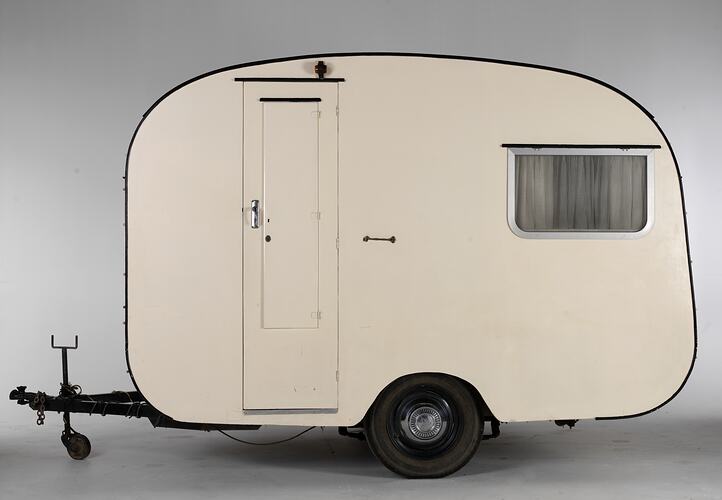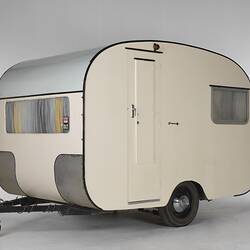Richard and Jean Hayes purchased their caravan on 5th August 1957 from 'Skyline Caravans' for 183 pounds. It is a 10 foot long and 6 foot six inch wide plywood caravan with one double and one single bed. An annex provides a second room, which was necessary to accommodate the family's two adults and four children (Barbara, Graeme, Ian and Linda). Initial holidays were to the Rosebud foreshore, although later they travelled to Lakes Entrance, Wilson's Promontory, Bright, Shepparton, Mildura, Swan Hill, Mount Gambier, Adelaide, and parts of New South Wales and Queensland.
Jean notes that 'for our holidays, we tended to base ourselves at one caravan park and then do lots of car trips into the surrounding areas. We used the caravan as a base for sleeping/eating, but spent the days travelling around. We saw much of Victoria in this way.' There isn't much space for storing clothes and belongings, so the family needed to travel light, and to take food that could survive without refrigeration, as there's no fridge in the caravan. However they did have an ice-chest to keep things cooler, then later an esky and finally they had the luxury of a small portable electric fridge for milk, butter and other cold items.
Jean remembers that 'we would pack the caravan the day before we left for our holiday. This was always very exciting. Richard always made a particular point of needing to pack the caravan so that the weight was evenly distributed - so it would be balanced for towing. We would leave home early for our holiday, setting the alarm for 5.00am and getting up while it was still dark outside. We would aim to be on the road by about 7.00am so we could get an early start to the day, and travel while the roads were quieter. We sometimes drew amused looks as people noticed first the small caravan and then counted the number of occupants in the car.' Once they arrived at the caravan park, they would try to find a spot with a good covering of fresh grass, which would form the floor for the annex. Erecting the annex was always the first task, and the guy ropes were useful for drying washing or for hanging towels on.
In the annex went two stretchers, made up with sheets and blankets taken from the beds at home, along with the boxes of non-perishable food, and the Primus stove which was used for cooking and for boiling water for frequent cups of tea. For a meals area they would sometimes dismantle the double bed in the caravan and place a folding table between the seats. However making up the beds was quite hard work, so often they would eat in the annex, perching on wooden folding chairs, the stretchers and wooden fruit boxes. With no television, and in the early days, no radio, their holidays in the caravan were quite basic and simple.
The caravan was usually connected to power at the camp site, which provided access to mains electricity to operate the internal fluorescent light and power for any electric appliances. They occasionally stayed at non-powered sites, and could use the car battery to power the small round lights at each end of the caravan, although they also used a kerosene pressure lamp to provide additional lighting and avoid draining the car battery.
Regardless of the availability of electricity, they usually depended on the Primus for cooking. Jean recalls that 'cooking toast over the flame of the Primus was a treat. It produced toast similar to that obtained from cooking toast over an open fire - better than that achieved by any toaster.' On windy days, the Primus flame was in constant danger of being blown around or blown out, so Richard cut the side from an old kerosene tin, and the Primus stood in the tin, which then could be positioned to exclude the wind.
Because of the small size of the caravan keeping warm was never a problem, with a few people inside and a closed door it was soon quite cosy. Although in seriously cold weather, they took holidays at varying times of the year, they used a small bar radiator to warm up the caravan. However those that slept in the annex, always the males of the family, were more vulnerable to the weather as the wind would blow under the caravan and the canvas walls of the annex. To stop this happening they would stack boxes and belongings under the edge of the caravan to block the wind. Jean notes that one year they 'had to place layers of newspaper beneath the thin mattresses on the stretchers to help those sleeping in them to keep warm.' She also recalls arriving at the caravan park in heavy rain one night and being unable to put up the annex so the entire family slept in the caravan for the first night, four in the double bed and two in the single bed. Although the usual sleeping arrangement was two in the double bed, two in the single bed and two in the stretchers.
Jean also remembers an 'amusing occasion when we were staying at Rosebud, and actually managed to get locked inside the caravan. We closed the door behind us, and it spontaneously latched with keys on the outside of the door. We had to summon a passerby to release us - rather embarrassing.'
Initially the caravan had tail-lights and a central brake-light, but no blinkers. Later the blinkers and brake-lights were added by Richard, to meet regulations. These lights, a new coat of paint to the outside and new curtains inside were the only changes made to the original caravan. All the interior paintwork and furnishings, other than the curtains, are original.
A plywood caravan is very vulnerable to the weather, so it was always been kept under cover when not in use. Initially it was kept in a shed on the poultry-farm owned by Richard and his brother, just up the road from where Richard and Jean have lived since they were married. Then later, when the farm was sold, Richard added an extension to the garage to house the caravan.
The caravan was towed over the years by three cars: Firstly, a Vanguard, then an HR Holden, and finally a Holden Torana. As the caravan is so small and light, it was generally an easy task to maneuver it into position by hand. The caravan was rarely opened between holidays, so it always retained a special smell. Jean remembers that 'the kids used to like going into the caravan and experiencing that smell. It was very evocative of special times on holiday.' Holidays were very different from home with the cramped sleeping arrangements, and camp cooking and eating, all a significant part of the holiday experience. The caravan was also used for other purposes, on one occasion; Ian lived in it for three months while working on a dairy farm in the neighbouring Yarra Valley. For this type of use, one person at a time living in the caravan was probably optimal.
More Information
-
Keywords
holidays (vacations), caravans, Leisure Activities, caravan parks
-
Authors
-
Article types

